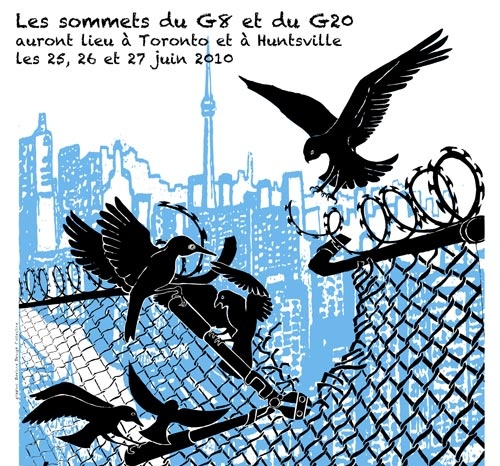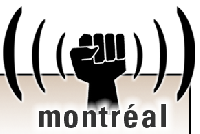 |
 |
 |
 |
 |
 |
|
 |
 |
 |
 |
 |
 |
 |
Régions du Québec |  |
 |
 |
|
 |
 |
|
 |
 |
|
 |
 |
 |
 |
 |
 |
Temas |  |
 |
 |
|
 |
 |
|
 |
|
 |
 |
 |
'Peace Under Fire': Montreal Activists Bear Witness to Palestinians' Plight
Montreal, September 16th - The limited but welcoming space of Café Esperanza's "Waiting Room" was filled to the brim Friday night for the Montreal launch of "Peace Under Fire", a compilation of stories about the experiences of International Solidarity Movement (ISM) activists in Israeli-occupied Palestine, and about the struggle of the Palestinian people in general.
Leila Khaled Mouammar -- a young militant with locally-based Solidarity for Palestinian Human Rights (SPHR) -- introduced the speakers by underlining the crucial role international observers play in bringing attention to the abuses of the occupation. "The ISM hasn't been able to get into the Gaza Strip recently," she said, contrasting the comparatively small amount of mainstream media concern about the recent and ongoing Israeli incursion into the Gaza Strip with more prominent coverage of the brutal invasion of Jenin refugee camp in 2002, which international observers managed to witness first-hand.
Attendees were then treated to the sounds of musician Sam Shalabi as the short video 'Sunset Over Qalqilya' was projected onto a screen. The camera, unmoving, was pointed at a portion of Israel's Apartheid Wall (the so-called 'Separation Barrier'). As the music played and the minutes passed, one could see the lights of the sunset fading behind the massive concrete structure filling up two-thirds of the screen. There was a stir in the audience as the distant sounds of sirens and gunfire suddenly broke the silence of the film. Far beyond the wall, one could make out lights on distant hills (Israeli settlements?). A few minutes of looking at this image made one realize that behind the wall, one lives in what is really an open-air prison -- there seems to be no way out left.
Leila explained that the West Bank town of Qalqilya is now completely surrounded by Israel's wall. There is but one entry and one exit left, and the 40,000 townspeoples' lives are literally dominated by the structure. Although Israeli state PR explains the wall away as a 'security barrier', "whether the wall makes Israelis safer is disputable, but it certainly does not make the Palestinians safer," she said. Almost every night, the occupation forces enter the town to ransack houses, make arrests and terrorize the population.
Radhika Sainath, the next speaker, is a New Yorker who lived in the West Bank from October 2002 to December 2003 under the ISM banner. Her contributions to the book help document the first two years of this historic nonviolent movement. Reading from "Peace Under Fire", she related an entry from her own journal, dated May 11, 2003: while attempting to protect children being used as human shields by the IDF in downtown Tulkarem, she and other 'internationals' were threatened repeatedly by the occupation soldiers. She was then kidnapped and brought to the local District Commander's office, resulting in her eventual deportation; a Palestinian activist accompanying her was not quite so 'lucky'. He was beaten into unconsciousness, and had to be hospitalized.
One of Sainath's more shocking experiences "haunts her to this day": in April 2003, she was made aware of a major round-up of Palestinians in Tulkarem refugee camp. She and other activists uncovered a massive displacement operation, involving the removal of all males aged 15 to 45 from the camp for several days, during which peoples' houses were "turned upside down", their belongings befouled or destroyed by IDF soldiers. Using the usual paper-thin security pretense, the Israeli state termed the operation a "big success". "Things like this go on all the time," said Radhika. One can only imagine what happens when 'internationals' aren't around.
According to Sainath, incidents like this one are part of the reason international activists are constantly in danger from the occupation forces. Most of the mainstream journalists never leave Israel proper, so war crimes like those described above can go on without scrutiny.
Sainath's appearance was followed by a heartfelt talk by Eileen Young, a soft-spoken 61-year-old Montrealer who decided to get involved with the ISM after her husband passed on several years ago. Young went to Palestine with a group of 14 other women aged 50 to 79, trained with ISM coordinators in Ramallah, and participated in a series of marches and demonstrations against the Wall, from Jerusalem to Biddu.
"The Wall is enormous," said Young. "There's no way to see anything over it". Soldiers man "watchtowers at various points," threatening anyone who approaches, peaceful or not. A nonviolent march of about 3000 people that she participated in was attacked with teargas, rubber bullets, and concussion grenades. Young also attested to the fact that Palestinian activists are treated much worse than 'internationals' or Israelis: when arrests were made in her presence by the IDF, the Israelis would tend to get a warning and be quickly set free, while the Palestinians were beaten and held until the internationals' pleas secured their release.
In Biddu, Young spoke with Palestinian farmers who had lost their livelihoods to Sharon's Wall. One resident was awakened in the middle of the night by the sounds of bulldozers destroying his olive grove. Villagers' attempts at replanting the precious trees were repeatedly crushed under the tracks of American-supplied bulldozers. The "constant harrassment, roadblocks and checkpoints" make peoples' lives extremely difficult -- "these are all things we need to speak about as much as we can", said Young.
Helga Mankovitz, a fellow silver-haired activist, was the last speaker tonight. She participated in the 2003 Freedom Summer campaign, having decided to join the ISM's Montreal chapter after the Jenin atrocities of 2002. She camped with activists near Tulkarem, spending most of her time on actions against the so-called "security barrier", actually breaking through one of its fences. Mankovitz said she experienced a real "eye-opener about the fence," learning "how much land had been confiscated, how much land was lost" -- for instance, some farmers in the village of Jayyous lost as much as 95% of their income when the Wall separated them from their fields.
Mankovitz also witnessed the poor treatment afforded to Palestinians living within Israel itself (i.e., inside the internationally-recognized 1948 border) while on a mission with the Holy Land Trust -- a Palestinian-led NGO -- this past summer. She told the story of an 'unrecognized' Palestinian village near Haifa whose residents had rebuilt it over a period of thirty years since the 1967 war despite the total lack of state-furnished amenities such as electricity, water, or garbage collection. "We were told that Israel is a democracy," said Mankovitz, "so I was shocked to find out how Palestinians are treated inside Israel."
Despite some of the traumatic things Mankovitz witnessed during her visits, she concluded her appearance on a positive note. Referring to the International Solidarity Movement and the other internationals working for peace in Palestine, she said "the people there gave me hope, and I think our presence there gave people hope."
Peace Under Fire (ISBN: 1844675017) is published by Verso, and available now.
| Documentos adjuntos | Tamaño |
|---|---|
| 18515.jpg | 0 bytes |
 |
 |
 |
 |
G20 Especial |  |
 |
 |
|
 |
 |
|
 |
Ofrecemos varios informes independientes y testimonios ...

Lista de acciones durante el 'contracumbre' a Toronto! Algunos medios independientes en Toronto G20 Centro de medios alternativos http://2010.mediacoop.ca Media Co-op Toronto http://toronto.mediacoop.ca Toronto Community Mobilization www.attacktheroots.net (en Inglés) |
 |
 |
 |
 |
 |
 |
 |
CMAQ: Vie associative |  |
 |
 |
|
 |
 |
|
 |
 Collectif à Québec: n'existe plus. Impliquez-vous ! |
 |
 |
 |
 |
 |
 |
 |
 |
|
 |
 |
 |
Ceci est un média alternatif de publication ouverte. Le collectif CMAQ, qui gère la validation des contributions sur le Indymedia-Québec, n'endosse aucunement les propos et ne juge pas de la véracité des informations. Ce sont les commentaires des Internautes, comme vous, qui servent à évaluer la qualité de l'information. Nous avons néanmoins une
Politique éditoriale
, qui essentiellement demande que les contributions portent sur une question d'émancipation et ne proviennent pas de médias commerciaux.
This is an alternative media using open publishing. The CMAQ collective, who validates the posts submitted on the Indymedia-Quebec, does not endorse in any way the opinions and statements and does not judge if the information is correct or true. The quality of the information is evaluated by the comments from Internet surfers, like yourself. We nonetheless have an
Editorial Policy
, which essentially requires that posts be related to questions of emancipation and does not come from a commercial media.


